

|
Home Updates Hydros Cars Engines Contacts Links Contact On The Wire |
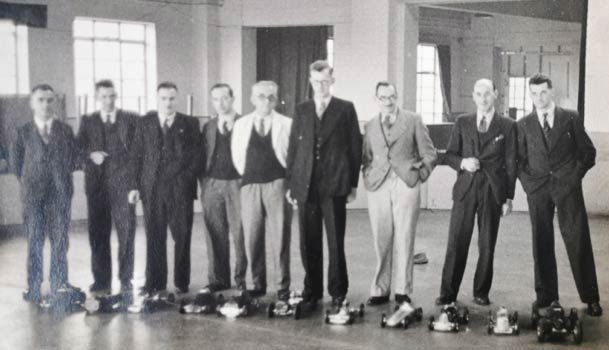
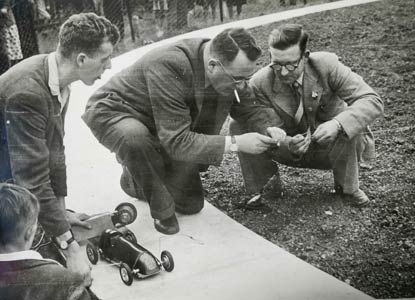 |
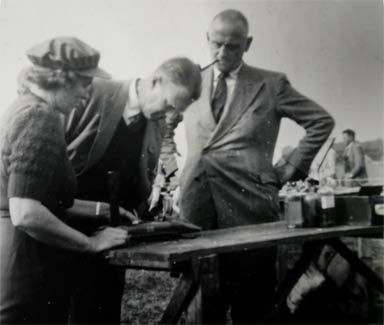 |
| 1066 MRC with 'Buck' type starter at the ready | Lt Col 'Goldie' Gardner signed Lucy Gascoignes MG |
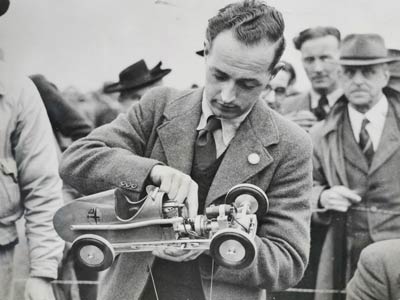 |
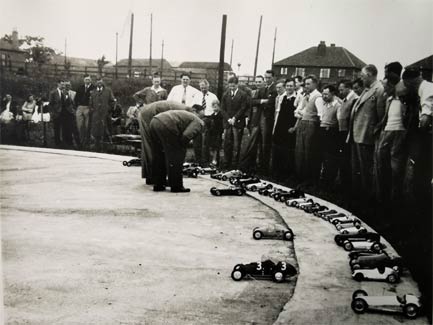 |
| Another replica of Gerry Buck's 2A | Line up for 'concours' judging |
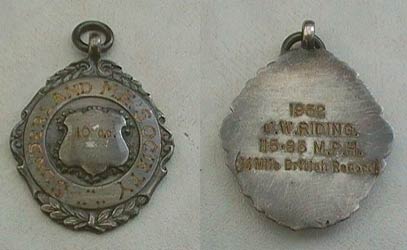 |
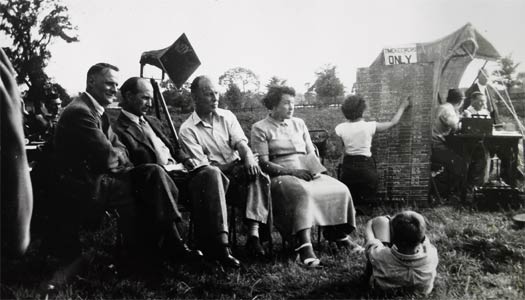 |
| Joe's British Record medal | Timekeepers and recorders, 1950s style |
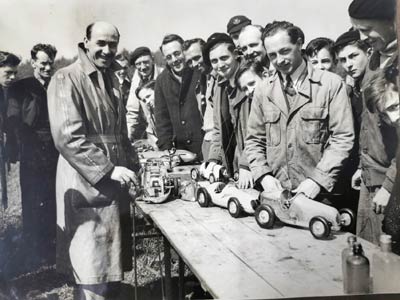 |
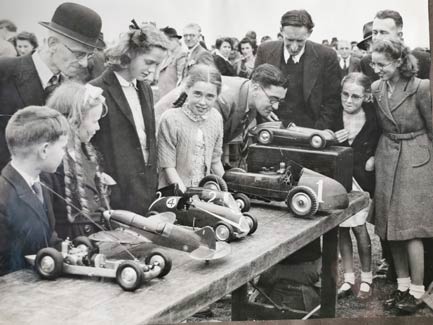 |
| Open meeting Leverhulme Park May 1949 | Gerry Buck's stable of cars |
| Newspaper reports from the Bolton Club track at Leverhulme Park | |
|
The
opening meeting of the Bolton and District Society of
Model Engineers was held at the Leverhulme park track
yesterday afternoon. In spite of the rain there was a
record number of entries sixty in the model racing car
competition. Societies from all over the North of
England had entered, and though no one expected records
to be broken, some of the speeds were remarkably high. |
Trials
of miniature racing cars at Leverhulme Park, yesterday,
attracted over 200 people to the racetrack of Bolton and
District Society of Model Engineers.
|
Gerry Buck's original car, 'Old Number I' was regularly pressed into service to perform the official opening of tracks by a local dignitary, Mayor or Mayoress. With its centrifugal clutch it could be started and sent on its way to break the tape for the first official run as can be seen below where everyone waits expectantly at the new Bolton Club track at Leverhulme park on the 17th July 1948, which was opened by the Deputy Mayor.
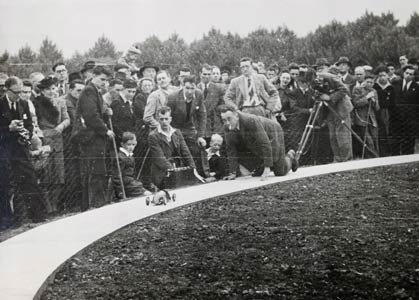 |
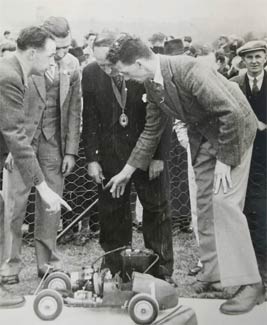 |
| Opening day at Leverhulme park with news cameras strategically placed. Gerry Buck prepares Old Number 1 for the opening | |
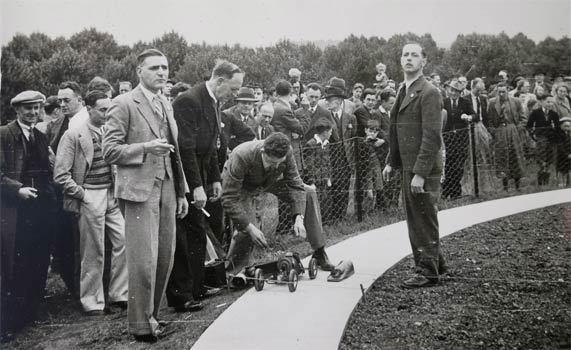
Gerry Buck prepares Old Number 1 with Hon Sec Joe
Riding standing to the right
The following newspaper cutting was from the opening of the Ossett and District Miniature Car Club on 12th June 1949. Several Car Clubs assisted in the meeting, Derby, Beverley, Sunderland, Harrogate and Bolton. Joe won the nomination race, an art which he seemed to be good at, and is probably why he saved article.
THE OBSERVER
| 1,500 SEE MIDGET CARS RACE AT OSSETT | ||
|
SPEEDS OF OVER
Nearly 1,500 people-at least two-thirds of whom were
from outside the town, attended the Ossett and District
Miniature Car Club’s inaugural races on Sunday
afternoon. The concrete track, built for £200 on the
former Army parade ground at Westfield Mill, was
considered so ideal for the sport that the Northern Area
finals for the national miniature car trophy competition
are to be staged there on July 24th. Electrical Timing The Ossett
Club’s meticulous organisation of the event shoed at
least they are whole hearted in their chosen sport. The
track, as has often been stated, is considered to be in
the top class, if not the best in Britain, and received
high praise from the competitors, who came from clubs at
Derby, Sunderland, Bolton, Harrogate and Beverley. The
timing was done electrically by Mr L G Brough, of the
Tyneside Society. Two contacts on the central pylon, to
which the cars running round the circular track were
tethered, operated a mechanism which ticked off the laps
as they were completed, and also recorded on a stop
watch, to which it was connected, the total time taken
for the 1/4mile. The time was then “translated” into
speed from a special chart. TemperamentalThe competitors prepare their models in a special “pit” and came on to the track singly, each being allowed three minutes in which to fasten his car to the cable and get it started. The cars with gears had their engines rotated by the use of an electrically operated wheel (part of the starting mechanism of an old Austin 7); the others had to be pushed around the track by their owners, using a pole, until the engine started up. As some of the latter appeared to be as temperamental as film stars. They afforded their owners a generous amount of exercise! |
When a car began to run round the track, the owner watched and listened until the note of the engine told him it had attained its maximum speed, upon which he raised his hand, and the timing device was put into operation. At the end of six laps (1/4 mile), the owner held a cloth near the edge of the track, which caught a lever protruding from the side of the model as it whizzed past and cut off the fuel supply, so bringing it gradually to a stop. 102 Miles Per Hour The cars were
run in three classes, the heaviest and fastest being the
10cc. Mr I. Moore of Derby, who attained the fastest
speed of the day (102.3mph) with a home made model
powered by a American Dooling engine, was the holder of
the British Open record speed of 107mph in this class.
He brought to Ossett the car with which he achieved this
record, but was unable to get it started, so had to use
another. Father and Son Win Prizes
There were four competitors in the 2.5cc class, in which
the highest speed recorded was 38.85mph by Mr Cooper of
Nottingham with an Oliver Special, the same type of car
which achieved the British record of 55.5mph.
Unfortunately, Mr Cooper and Mr J Yates, of the Ossett
Club, made only one run each, and failed to get going in
the allotted time for their second, so did not qualify
for a prize. Each competitor had to complete the ¼ mile
twice, the average speed in both qualifying for the
award. Mr D Nicholson of Beverly with an ED Frazer Nash
won the first prize with 36.81 average, and his fourteen
year old son, F.G. Nicholson came second with 36.74mph. 10cc Races Eight competitors entered the pits for the 10cc races, but only six cars actually ran. The home made model of R E Elliott of Derby, started, but fizzled out owing to its plugs having oiled up, and, when the engine belched smoke, its owner took it back to the pits. Mr Burton of Harrogate, also failed to start, his clutch having seized. |
First prize went to Mr Moore, of Derby, with an average
speed of 98.91mph. On his first run he clocked 102.3mph
in 8.8 seconds, and on the second 96.75mph in 9.4
seconds. Second was Mr D W Parkin, of Derby, with
97.84mph, his speed on his second run being exactly
100mph. He was using an American machine called a
Pacemaker Hornet. Nome of the other contestants came
within 20mph of these top speeds. At the end of the
racing, Mr Parkin made an unofficial attempt on the
British record, but again only succeeded in clocking
100mph. Too Dry For High Speeds Mr K Shaw
(Chairman of the Ossett Club) told an “Observer”
reporter that, to achieve a speed of 102.3mph so near to
the record, was a credit to the Ossett Club. Speeds
would undoubtedly have been greater had the atmosphere
not been so dry; and element of dampness greatly assists
small engines.
|
Dundee Open
Meeting
June 18th 1950
| Scottish Speed Challenge Trophy Various newspaper reports | ||
|
MINICAR RACING NEW TROPHY GOES SOUTH F.G. Buck, Stoke on
Trent, is the first holder of the Scottish
Individual Miniature Race Car Speed Championship.
Results:- FG Buck (McCoy) average 106; FG Buck (Topsy) 104; JC Cook Sunderland (Dooling) 99.1; K Smith Dundee (McCoy) 92.7; W Armstrong Dundee (Rowell) 92; C Catchpole Surrey (Dooling) 86; A Fyife Dundee (Rowell) 81; C Catchpole (5cc Dooling) 81; EW Wilson Carnoustie (Hornet) 79.6; E Armstrong Sunderland (Nordec) 72; JW Riding, Bolton (Rowell) 43.5; J Soutar Dundee (Rowell) 42.25; FC Petrie Sunderland (Dooling) 43.5; Dr G Fraser Dundee (Dooling) 50.5; |
Midget Car averages 106.63mph at Dundee Showers and a greasy
concrete track were against record breaking runs
when Dundee and District Miniature racing Car
Association held their Scottish Open Challenge event
at Riverside Park, Dundee, yesterday. Unlucky C.M. Catchpole, a Surrey driver, clocked 108mph in his Dooling car during practice trials in the morning, but while running his second competitive round, a mechanical defect brought his speed down to 87mph, In a run after the competition, his figure rocketed again to 107.7mph. |
Baby Car wins At 106.6mph Nearly 150 motor-cars
were parked in Dundee’s Riverside Drive yesterday,
while a 2,000 crowd watched miniature racing cars
whine at more than 100mph around a 75foot diameter
concrete strip. It was the first contest, for the
Scottish Speed Challenge Trophy. It will be an
annual event.
|
Our thanks to James Riding for these super images and photos of Joe's
medals recognising his long standing record.
©copyrightOTW2021